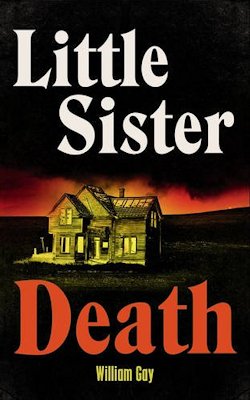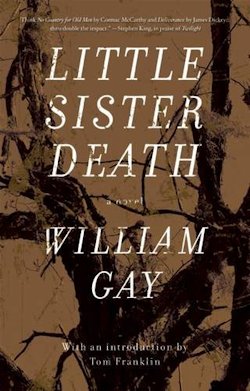As his friend Tom Franklin notes in the intimate introduction with which Little Sister Death begins, the late, great William Gay’s lost horror novel “is the most metafictional thing [he] ever wrote—it’s about a writer, obsessed with a haunting, who moves his family to the site” of said unearthly events.
Gay, for his part, didn’t go quite as far as that, but he had “long been fascinated with the Bell Witch phenomenon in Tennessee, and even had his own encounter with, perhaps, an echo of the Bell Witch herself.” That true tale acts at a capstone on the unsettling story at the centre of Little Sister Death, but there’s a goodly amount of truth, too, in the several hundred posthumously published pages preceding the author’s authentic account of his own eerie experience.
Like William Gay, whose fearsome first novel won the 1999 James A. Michener Memorial Prize, the debut of Little Sister Death‘s central character David Binder is something of a success. Not necessarily commercially—it’s no bestseller—but it wins enough awards to keep Binder and his kin in business.
Sadly, the critically acclaimed young author’s second novel does not cement his literary legacy in the way Provinces of Night did in Gay’s case. Instead, it’s rejected, and rather than redrafting the manuscript, a briefly defeated Binder takes his agent’s advice to “write a genre novel […] something we can sell to the paperback house” to heart. A trip to his local bookstore later, he has his subject: the Beale Haunting—Gay’s thinly veiled rendition of the so-called Curse of the Bell Witch, which, for what it’s worth, The Blair Witch Project is believed to have been based on.
But back to Binder, who, with the last of his advance, takes a six month lease on “a ruined backwoods mansion” where in 1838 Jacob Beale was scared into an early grave; and where, a century later, one Owen Swaw massacred his entire family:
No angle seemed to be true to the eye’s expectation. The horizontal seemed slightly out of level, the vertical just a fraction out of plumb. Perhaps this very imbalance lay at the root of things; an eye perpetually beguiled and a brain constantly reevaluating these images might insanity to it like a comforter. Yet he knew the evil predated the house, and he looked farther to the land itself, the sedgefield running stonily down the hill to the outbuildings, to what must have been the carriage house, and far beyond that, the ruins of the slave cabins.
It was an evil perhaps indigenous to the slope and rise of the land, to the stark austerity of the woods surrounding the ruined plantation. For whatever course, it was a verifiable fact that evil had happened here.
 But here is where Binder needs to be. He knows no other way to tell the Dell’s terrible tale than to experience its effects himself. Which is fine, I figure—you write what you know, you know? But Binder’s ever-growing need to know places his wife and child in grave danger, and his obsession—”to unstring the secrets the house held, to unravel the Gordian knot time and myth had only tightened”—only escalates from there:
But here is where Binder needs to be. He knows no other way to tell the Dell’s terrible tale than to experience its effects himself. Which is fine, I figure—you write what you know, you know? But Binder’s ever-growing need to know places his wife and child in grave danger, and his obsession—”to unstring the secrets the house held, to unravel the Gordian knot time and myth had only tightened”—only escalates from there:
The book he was writing was important to him, but it was becoming secondary to the mystery. All the things that were supposed to have gone on down here: had they or hadn’t they? Had all those people lied? It was over a century ago, layered with myth and folklore, but what was the basis of it? He felt he had the pieces to an enormously complex puzzle, needed only time to figure out where they went.
Truth be told, time is not on Binder’s side. Nor, sadly, was it with the author of this tremendously taut horror novel, for as exquisite as Little Sister Death is, I’m afraid it also feels… unfinished.
According to A Note from the Publisher, said text was “compiled and transcribed from [Gay’s] handwritten notebooks and a typescript discovered among his papers” at the Sewanee University Library, and happy as I am to have had the chance to read it regardless, a great many of the elements introduced in Little Sister Death are less than fully-fledged.
Certain characters—Binder’s wife in particular—are given such short shrift that you have to imagine Gay would have gotten back to them, given a little longer with his metafictional manuscript, and there are plenty of plot threads that remain resolutely unresolved by the book’s conclusion. As to that, though the ending itself is somewhat satisfactory in that it sort of suggests what might yet happen next, it’s so utterly abrupt I found myself reading it repeatedly to be sure I wasn’t missing something critical.
Little Sister Death is not, then, the unqualified success I—as a dyed-in-the-wool devotee of Gay’s southern gothic goodness—wish it were, but despite these drawbacks, allow me to repurpose Binder’s feelings for the haunted house at the heart of the narrative and say “there was a timeless quality about it that seemed to diminish any problems he might have.”
Like the damned dog that prows the periphery of the fiction, a hellish sense of tension creeps inexorably towards the reader over the length and depth of Little Sister Death. The atmosphere, in the interim, is a watercolour wash of otherworldly wickedness, whilst Cormac McCarthy meets the likes of Laird Barron in Gay’s occasional conjuring of the cosmic. Cannily crafted, exceptional in its storytelling and doubly seductive in its sultry Southern setting, what there is of Little Sister Death is literary horror of the highest order.
Little Sister Death is available from Dzanc in the US and Faber & Faber in the UK.
Niall Alexander is an extra-curricular English teacher who reads and writes about all things weird and wonderful for The Speculative Scotsman, Strange Horizons, and Tor.com. He lives with about a bazillion books, his better half and a certain sleekit wee beastie in the central belt of bonnie Scotland.










